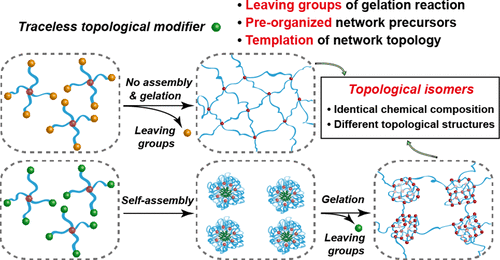当前位置:
X-MOL 学术
›
J. Am. Chem. Soc.
›
论文详情
Our official English website, www.x-mol.net, welcomes your feedback! (Note: you will need to create a separate account there.)
Leaving Groups as Traceless Topological Modifiers for the Synthesis of Topologically Isomeric Polymer Networks
Journal of the American Chemical Society ( IF 15.0 ) Pub Date : 2018-10-17 , DOI: 10.1021/jacs.8b07967 Yuwei Gu 1 , Dominik Schauenburg 2 , Jeffrey W. Bode 2 , Jeremiah A. Johnson 1
Journal of the American Chemical Society ( IF 15.0 ) Pub Date : 2018-10-17 , DOI: 10.1021/jacs.8b07967 Yuwei Gu 1 , Dominik Schauenburg 2 , Jeffrey W. Bode 2 , Jeremiah A. Johnson 1
Affiliation

|
The chemical and topological structure of polymer networks can seldom be orthogonally controlled. For example, novel network topologies are often accessed via the direct incorporation of supramolecular assemblies into the network structure, introducing potentially undesirable chemical components. Here, we address this deficiency by programming topology into network precursors through the incorporation of self-assembly motifs in leaving groups, which become "traceless topological modifiers." Our method enables us to control polymer network topology using self-assembled structures as templates that are not themselves incorporated into the network. We demonstrate this strategy using a model network formed through potassium acyltrifluoroborate (KAT) ligation. Two four-arm polyethylene glycol (PEG)-based star polymers prepared with either O-ethyl or O-octyl carbamoyl hydroxylamine chain ends serve as network precursors, where differences in chain end hydrophobicity produce different self-assembly states in solution. Addition of a bis-KAT reagent to these star polymers induces amide bond formation and concomitant expulsion of the ethyl or octyl traceless topological modifiers, producing topologically isomeric PEG gels with identical chemical compositions yet vastly different physical properties. This work highlights the impact of topology on polymer network properties and provides a new strategy, traceless topological modification, for polymer network design.
中文翻译:

离开基团作为用于合成拓扑异构聚合物网络的无痕拓扑修饰剂
聚合物网络的化学和拓扑结构很少可以正交控制。例如,通常通过将超分子组件直接结合到网络结构中来访问新的网络拓扑,从而引入潜在的不良化学成分。在这里,我们通过在离去基团中加入自组装基序将拓扑编程为网络前体来解决这一缺陷,这些基序成为“无痕拓扑修饰符”。我们的方法使我们能够使用自组装结构作为模板来控制聚合物网络拓扑,这些结构本身并未并入网络中。我们使用通过酰基三氟硼酸钾 (KAT) 连接形成的模型网络来演示此策略。用 O-乙基或 O-辛基氨基甲酰基羟胺链端制备的两种基于四臂聚乙二醇 (PEG) 的星形聚合物作为网络前体,其中链端疏水性的差异在溶液中产生不同的自组装状态。将双-KAT 试剂添加到这些星形聚合物中会诱导酰胺键的形成和伴随的乙基或辛基无痕拓扑改性剂的排出,从而产生具有相同化学组成但物理性质却大不相同的拓扑异构 PEG 凝胶。这项工作突出了拓扑对聚合物网络特性的影响,并为聚合物网络设计提供了一种新的策略——无痕拓扑修饰。其中链端疏水性的差异在溶液中产生不同的自组装状态。将双-KAT 试剂添加到这些星形聚合物中会诱导酰胺键的形成和伴随的乙基或辛基无痕拓扑改性剂的排出,从而产生具有相同化学组成但物理性质却大不相同的拓扑异构 PEG 凝胶。这项工作突出了拓扑对聚合物网络特性的影响,并为聚合物网络设计提供了一种新的策略——无痕拓扑修饰。其中链端疏水性的差异在溶液中产生不同的自组装状态。将双-KAT 试剂添加到这些星形聚合物中会诱导酰胺键的形成和伴随的乙基或辛基无痕拓扑改性剂的排出,从而产生具有相同化学组成但物理性质却大不相同的拓扑异构 PEG 凝胶。这项工作突出了拓扑对聚合物网络特性的影响,并为聚合物网络设计提供了一种新的策略——无痕拓扑修饰。生产具有相同化学成分但物理性质却大不相同的拓扑异构 PEG 凝胶。这项工作突出了拓扑对聚合物网络特性的影响,并为聚合物网络设计提供了一种新的策略——无痕拓扑修饰。生产具有相同化学成分但物理性质却大不相同的拓扑异构 PEG 凝胶。这项工作突出了拓扑对聚合物网络特性的影响,并为聚合物网络设计提供了一种新的策略——无痕拓扑修饰。
更新日期:2018-10-17
中文翻译:

离开基团作为用于合成拓扑异构聚合物网络的无痕拓扑修饰剂
聚合物网络的化学和拓扑结构很少可以正交控制。例如,通常通过将超分子组件直接结合到网络结构中来访问新的网络拓扑,从而引入潜在的不良化学成分。在这里,我们通过在离去基团中加入自组装基序将拓扑编程为网络前体来解决这一缺陷,这些基序成为“无痕拓扑修饰符”。我们的方法使我们能够使用自组装结构作为模板来控制聚合物网络拓扑,这些结构本身并未并入网络中。我们使用通过酰基三氟硼酸钾 (KAT) 连接形成的模型网络来演示此策略。用 O-乙基或 O-辛基氨基甲酰基羟胺链端制备的两种基于四臂聚乙二醇 (PEG) 的星形聚合物作为网络前体,其中链端疏水性的差异在溶液中产生不同的自组装状态。将双-KAT 试剂添加到这些星形聚合物中会诱导酰胺键的形成和伴随的乙基或辛基无痕拓扑改性剂的排出,从而产生具有相同化学组成但物理性质却大不相同的拓扑异构 PEG 凝胶。这项工作突出了拓扑对聚合物网络特性的影响,并为聚合物网络设计提供了一种新的策略——无痕拓扑修饰。其中链端疏水性的差异在溶液中产生不同的自组装状态。将双-KAT 试剂添加到这些星形聚合物中会诱导酰胺键的形成和伴随的乙基或辛基无痕拓扑改性剂的排出,从而产生具有相同化学组成但物理性质却大不相同的拓扑异构 PEG 凝胶。这项工作突出了拓扑对聚合物网络特性的影响,并为聚合物网络设计提供了一种新的策略——无痕拓扑修饰。其中链端疏水性的差异在溶液中产生不同的自组装状态。将双-KAT 试剂添加到这些星形聚合物中会诱导酰胺键的形成和伴随的乙基或辛基无痕拓扑改性剂的排出,从而产生具有相同化学组成但物理性质却大不相同的拓扑异构 PEG 凝胶。这项工作突出了拓扑对聚合物网络特性的影响,并为聚合物网络设计提供了一种新的策略——无痕拓扑修饰。生产具有相同化学成分但物理性质却大不相同的拓扑异构 PEG 凝胶。这项工作突出了拓扑对聚合物网络特性的影响,并为聚合物网络设计提供了一种新的策略——无痕拓扑修饰。生产具有相同化学成分但物理性质却大不相同的拓扑异构 PEG 凝胶。这项工作突出了拓扑对聚合物网络特性的影响,并为聚合物网络设计提供了一种新的策略——无痕拓扑修饰。


























 京公网安备 11010802027423号
京公网安备 11010802027423号